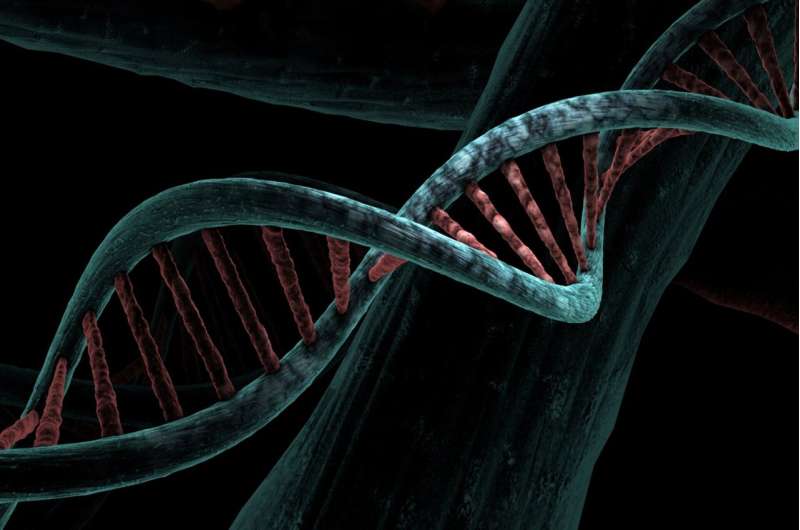This article has been reviewed according to Science X's editorial process and policies. Editors have highlighted the following attributes while ensuring the content's credibility:
fact-checked
peer-reviewed publication
trusted source
proofread
DNA becomes our 'hands' to construct advanced polyhedral nanoparticles

In a paper published in Science Jan. 18, scientists Chad Mirkin and Sharon Glotzer and their teams at Northwestern University and University of Michigan, respectively, present findings in nanotechnology that could impact the way advanced materials are made.
The paper describes a significant leap forward in assembling polyhedral nanoparticles. The researchers introduce and demonstrate the power of a novel synthetic strategy that expands possibilities in metamaterial design. These are the unusual materials that underpin "invisibility cloaks" and ultrahigh-speed optical computing systems.
"We manipulate macroscale materials in everyday life using our hands," said Mirkin, the George B. Rathmann Professor of Chemistry at the Weinberg College of Arts and Sciences.
"Even preschool children can easily manipulate toy building blocks, fitting them together nicely to fill space. At the nanoscale, we can't use our hands to manipulate nanoparticle building blocks because of the vast size difference between our hands and the nanoparticles.
"Because DNA and nanoparticles have dimensions on the same length scale and we can chemically encode particles with DNA so they can be designed to recognize complementary particles, and therefore the DNA effectively becomes our hands."
These "hands" are designed to recognize particles with complementary shapes and arrange them to form space-filling structures.
A new method to make useful nanoparticle crystals
Conventional approaches to engineering nanoparticle crystals using DNA as the bonding element have yet to lead to three-dimensional (3D) space-filled tiling arrangements. To attain these useful space-filled crystals, Northwestern researchers employed shorter and more flexible molecular ligands than those typically used. Specifically, they employed oligoethylene glycol–modified DNA.
The oligoethylene glycol units act as a type of shock absorber that adjusts to the appropriate length to make certain the shapes can fit together in a near-perfect manner.
So far, this new building material has led to the synthesis of 10 new colloidal crystals that would not be possible to prepare otherwise and that have the potential to be used for the design and construction of metamaterials with unprecedented properties.
Letting true colors shine through
Nanoparticles are inherently imperfect—even individual ones produced in the same synthetic batch have slightly different sizes and shapes—and this feature can limit their ability to efficiently fill space when they assemble. Also, the DNA strands traditionally used in assembly are almost as long or longer than the diameter of the particles and thus have masked some crucial contributions of particle geometry in bonding. The result—particles with well-defined facets have been found to behave like ones that are less geometrically complex.
The team overcame these two hurdles by decoupling the contributions of the DNA ligand shell and the nanoparticle shape. Indeed, the DNA strands are essential to the assembly process—they are the "glue" that is manipulated to hold the particles together. But the researchers used DNA strands that were both much shorter and more flexible.
The short DNA allows the shape-complementarity of the nanoparticles to be both revealed and then reflected in the assembled product. The flexible DNA provides the wiggle room needed to accommodate slight imperfections in polyhedral nanoparticle size and shape.
This wiggle room allows nanoparticles with imperfect shapes to create tilings like those of the perfect shapes. In this way, highly ordered assemblies were formed via facet-to-face alignment.
Two for the price of one
"By decoupling the contributions of the DNA ligand shell and core shape, we've unlocked a new frontier in nanotechnology, enabling the creation of highly ordered colloidal crystals with shapes and sizes previously deemed impossible to make. This breakthrough not only expands the scope of colloidal crystals but also presents a versatile toolkit for designing metamaterials," said former Mirkin Group graduate student Wenjie Zhou, one of the study's lead authors.
Remarkably, this new strategy permits two significant design strategies. Firstly, imperfect polyhedral building blocks or those with entirely different shapes can be assembled into highly ordered space-filling structures. Secondly, flexible DNA provides additional degrees of freedom in the assembly of non-space-filling polyhedral nanoparticles, leading to the creation of complex crystals with symmetries not previously achievable with colloidal crystal engineering with DNA.
Expanding the design space
The research demonstrates the ability to engineer large, space-filling colloidal crystals using simple geometric considerations. The presented assemblies represent only a fraction of this revolutionary strategy's vast design space. Because of this, it will be important to couple experiment and theory to arrive at useful target structures.
"Here, the experimental work was confirmed by simulation in silico, and our theory work offered new insights into what was happening ex silico," said Glotzer, the Anthony C Lembke Department Chair of Chemical Engineering.
"Using a combination of both research modes and working together, our groups learned much more about the system than we ever could have working independently. This is why interdisciplinary work represents the absolute best of science and engineering."
In many ways, these results were unexpected. Mirkin says, "It is far from obvious that one can take two highly imperfect systems and design DNA bonding elements that yield near-perfect space-filled crystals. It is a stunning demonstration of the utility of nature's blueprint for encoding a materials outcome."
Mirkin and Glotzer are the co-corresponding authors of the paper titled "Space-tiled colloidal crystals from DNA-forced shape-complementary polyhedra pairing."
More information: Wenjie Zhou et al, Space-tiled colloidal crystals from DNA-forced shape-complementary polyhedra pairing, Science (2024). DOI: 10.1126/science.adj1021. www.science.org/doi/10.1126/science.adj1021
Journal information: Science
Provided by Northwestern University





















